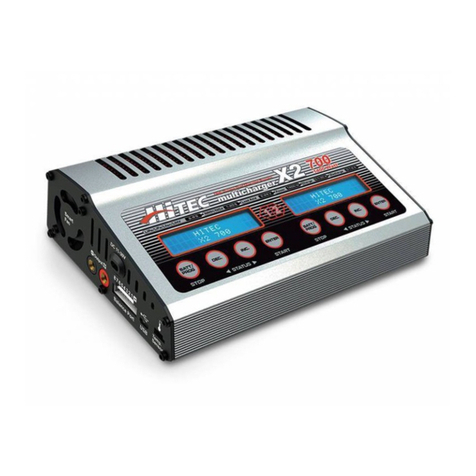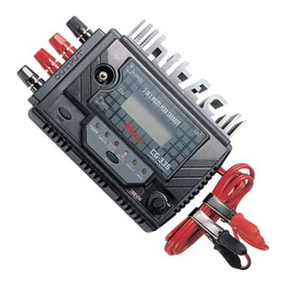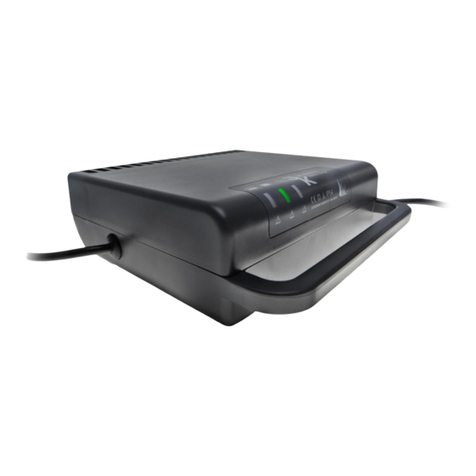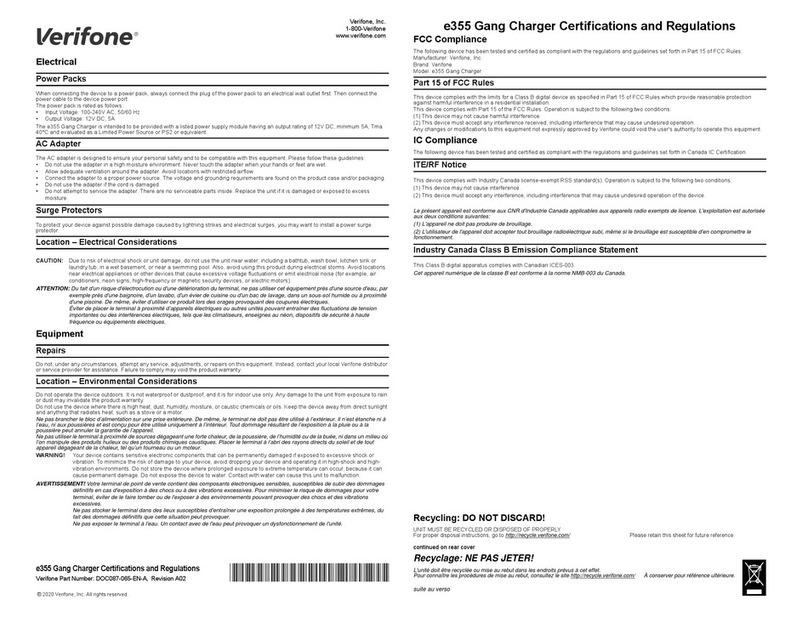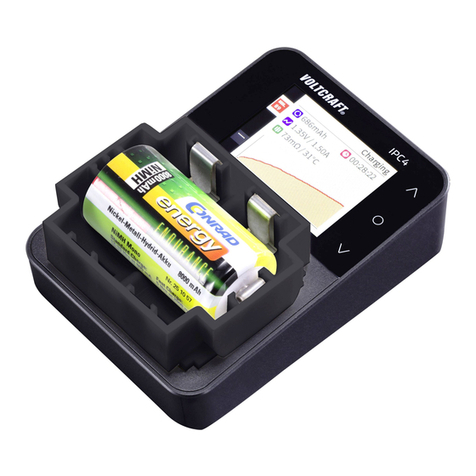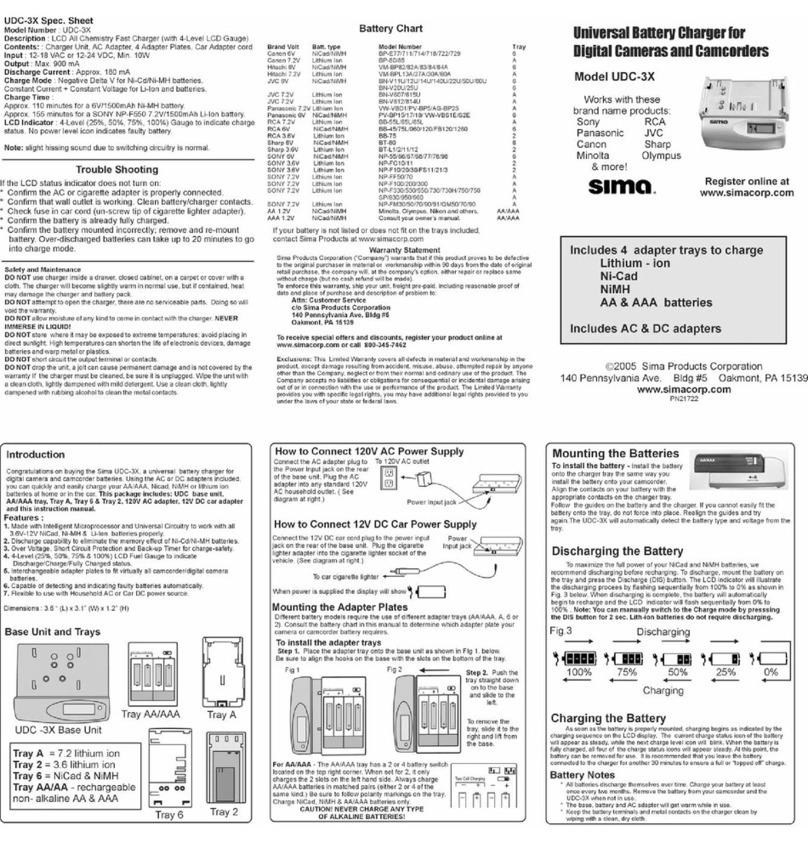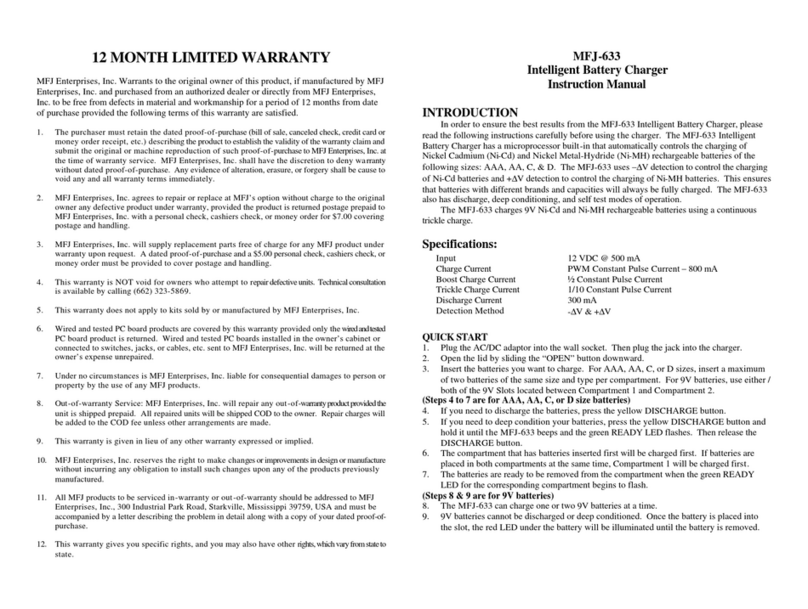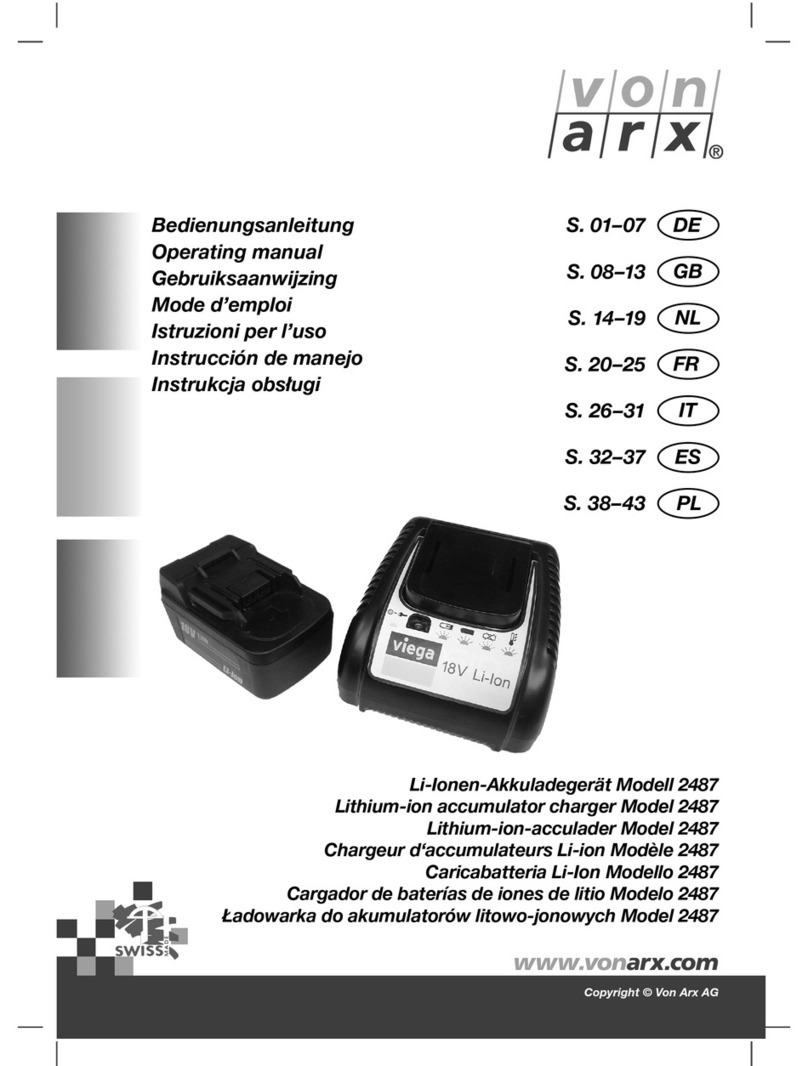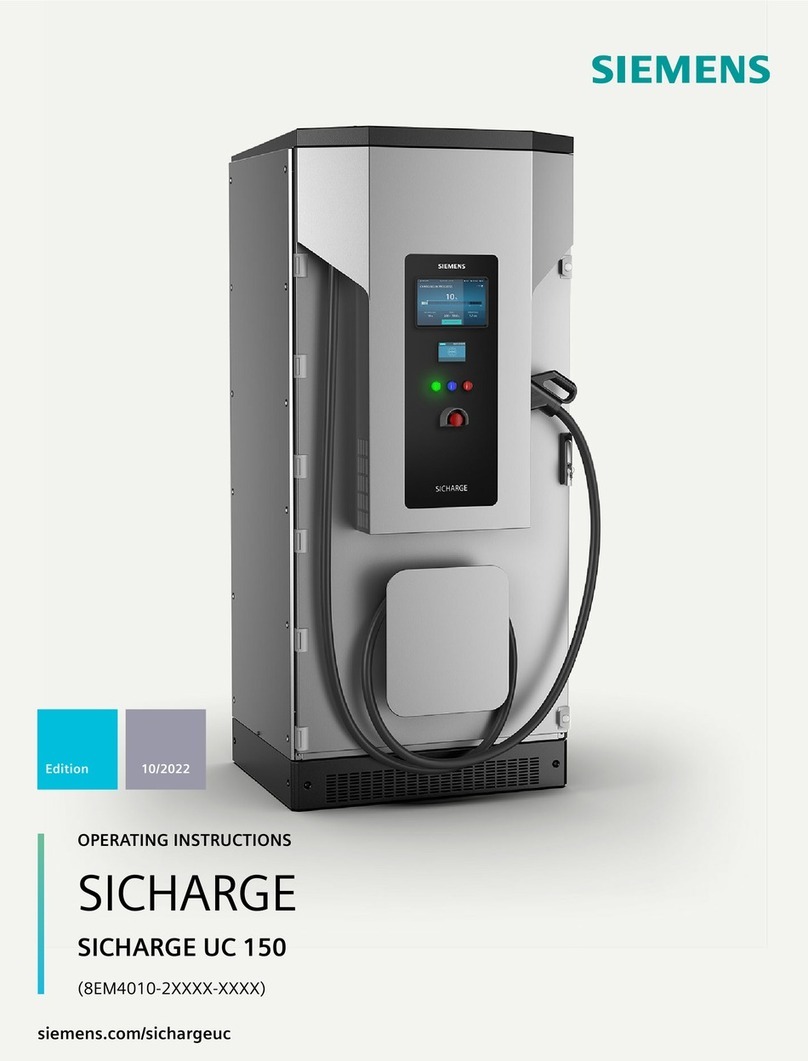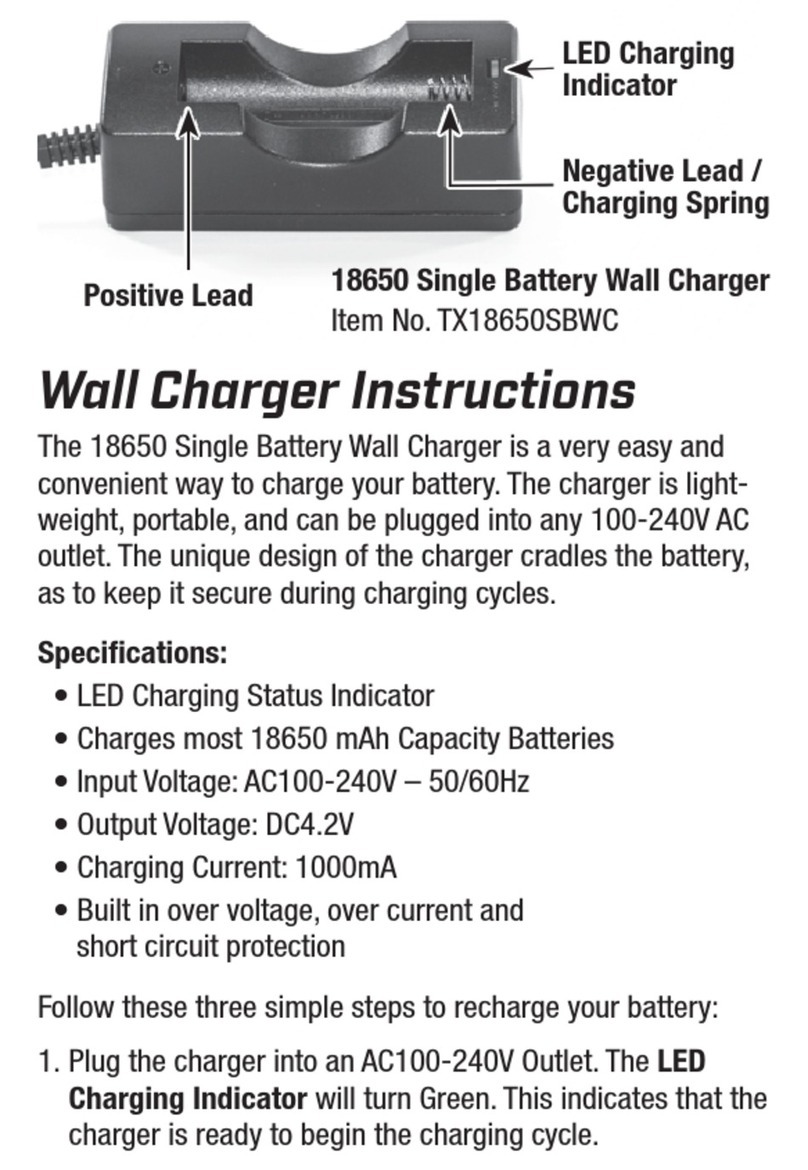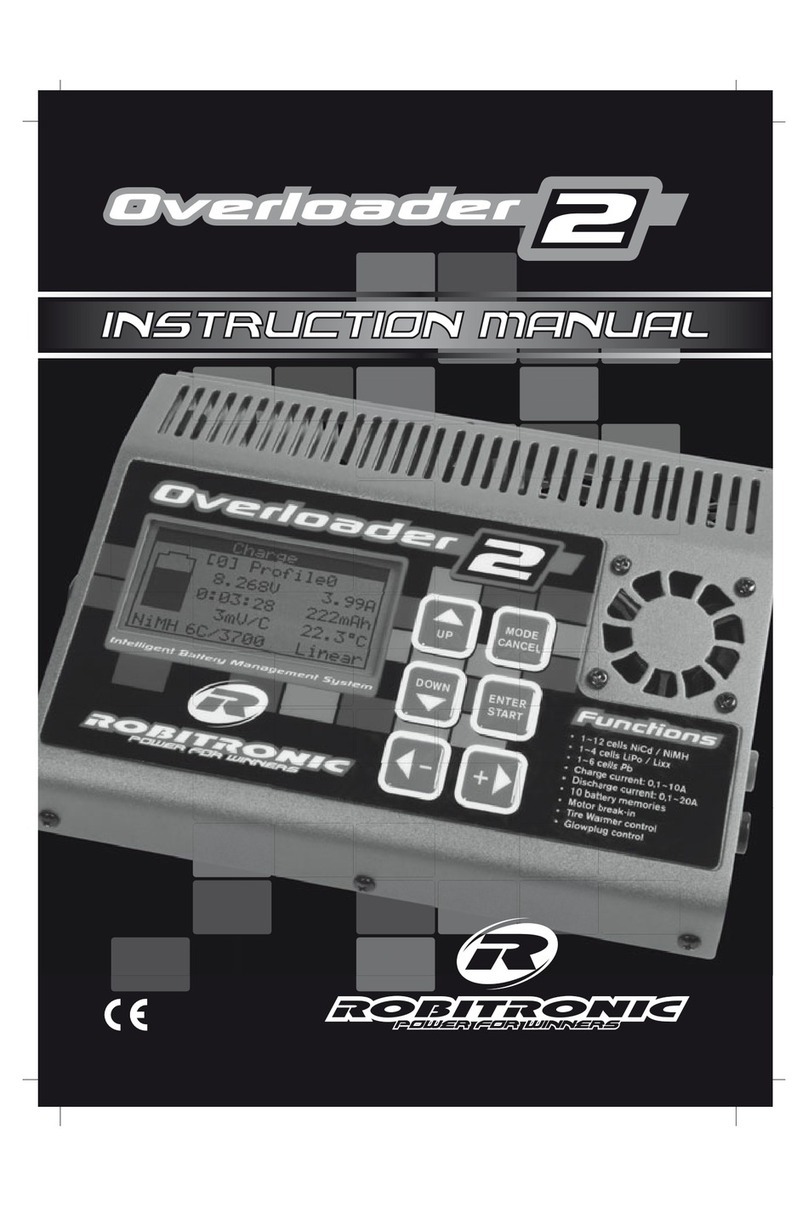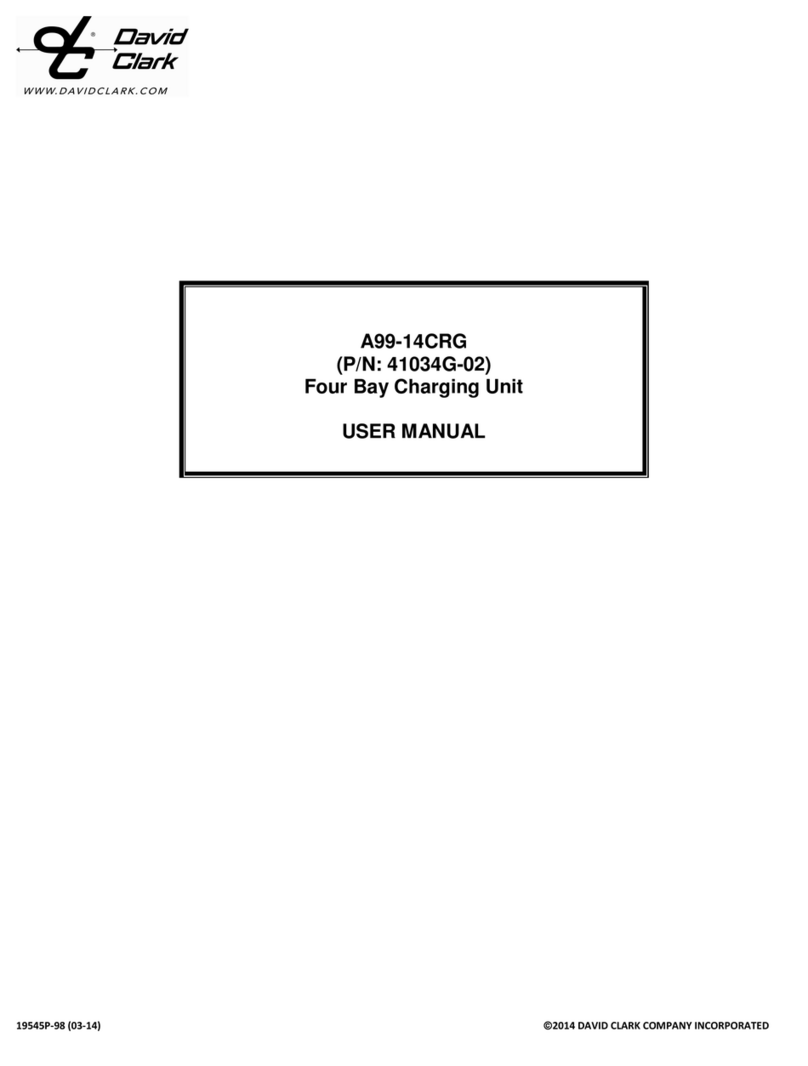Hi-Tec RDX1 PRO User manual

1
INSTRUCTION MANUAL
WARNING: THE CHARGING AND DISCHARGING OF RC HOBBY BATTERIES CAN BE DANGEROUS. FAILURE TO FOLLOW
THE INSTRUCTIONS AND WARNINGS IN THIS MANUAL MAY RESULT IN PROPERTY DAMAGE AND/OR LOSS OF LIFE.
INSTRUCTION MANUAL
INSTRUCTION MANUAL
AC/DC INPUT,
PROFESSIONAL
BALANCE CHARGER
/ DISCHARGER
MULTICHARGER

2
Table of Contents
Introduction................................................................................................. 3
Warnings and Safety Notes......................................................................... 4
Charger Layout ............................................................................................ 8
Specications............................................................................................... 9
Features...................................................................................................... 10
Charger Connections................................................................................. 12
Getting Started.......................................................................................... 13
Operating the Charger .............................................................................. 14
Charging Your Battery............................................................................... 18
System Settings ......................................................................................... 19
Battery Meter............................................................................................. 23
Warnings and Error Messages .................................................................. 24
Using the Charge Control Software - “Charge Master” ..................... 25
Warranty and Service ................................................................................ 26
Disposal and Proposition 65 Warning ..................................................... 27
Regulatory Compliance............................................................................. 27

3
Introduction
Congratulations on your choice of the RDX1 Pro charger from Hitec RCD, USA.
The RDX1 Pro is a high-performance, microprocessor-controlled charger/
discharger with battery management capabilities that are suitable for use with
most popular battery types. The RDX1 Pro also features integrated balancing for
six-cell, Lithium-Polymer (LiPo), Lithium-Ferrite (LiFe) and Lithium-Ion (LiIon), as
well as the latest high voltage Lithium-Polymer (LiHV) batteries.
Please read this entire operating manual before using the RDX1 Pro Charger.
If you are unsure of its proper operation after reading the manual, please seek
advice from an experienced hobbyist or someone familiar with proper battery
charging procedures.
THE CHARGING AND DISCHARGING OF RC HOBBY BATTERIES CAN BE
DANGEROUS. FAILURE TO FOLLOW THESE EXPLICIT WARNINGS CAN
RESULT IN PROPERTY DAMAGE AND/OR LOSS OF LIFE.
ANEVER LEAVE YOUR CHARGER UNATTENDED WHILE IN OPERATION.
ANEVER CHARGE ON OR AROUND COMBUSTIBLE MATERIALS.
ANEVER CHARGE A DAMAGED BATTERY PACK.
ALOW COST, NO-NAME BATTERY PACKS POSE THE MOST DANGER. WE
RECOMMEND YOU ONLY USE BATTERY PACKS THAT ARE SOLD AND
WARRANTED BY A REPUTABLE COMPANY.
AIT IS HIGHLY RECOMMENDED THAT YOU UTILIZE A SAFETY DEVICE
SUCH AS A STEEL CASE OR LiPo SACK™ WHILE CHARGING LITHIUM
CHEMISTRY BATTERIES.
AIT IS HIGHLY RECOMMENDED THAT YOU KEEP AN OPERABLE“CLASS A”
FIRE EXTINGUISHER IN THE CHARGING AREA.
FAILURE TO FOLLOW THESE WARNINGS CAN BE CONSIDERED
NEGLIGENCE BY THE OPERATOR AND MAY NEGATE ANY CLAIMS FOR
DAMAGES INCURRED.
Hitec RCD USA will not be held responsible for any damages or injuries that
may occur by persons who fail to follow these warnings or who fail to properly
follow the instructions in this manual.
Warning

4
These warnings and safety notes are of the utmost importance. You must
follow these instructions for maximum safety. Failure to do so can damage the
charger and the battery and in the worst cases, may cause a re.
NEVER LEAVE THE CHARGER UNATTENDED WHILE IT IS CONNECTED
TO ITS POWER SOURCE. IF ANY MALFUNCTION IS FOUND, TERMINATE
THE PROCESS AT ONCE AND REFER TO THE OPERATION MANUAL.
AThe allowable AC input voltage is 100 - 240V AC
AThe allowable DC input voltage is 11-18V DC.
AKeep the charger away from dust, damp, rain, heat, direct sunlight and
excessive vibration.
AIf the charger is dropped or suers any type of impact, it should be
inspected by an authorized service station before using it again.
AThis charger and the battery should be put on a heat-resistant, non-
ammable and non-conductive surface.
ANever place a charger on a car seat, carpet or similar surface. Keep all
ammable volatile materials away from the operating area.
AMake sure you know the specications of the battery to be charged or
discharged to ensure it meets the requirements of this charger. If the
program is set up incorrectly, the battery and charger can be damaged.
AFire or explosion can occur due to overcharging.
ATo avoid a short circuit between the charge lead, always connect the
charge cable to the charger rst, then connect the battery. Reverse the
sequence when disconnecting.
Warning: Be sure to read this section for your own safety.
Caution: Be sure to read this section to prevent accidents
and damage to your charger.
Tip: This section will help you maximize the performance of
your charger.
Note: This section will provide more detailed explanations.
Warnings and Safety Notes
Caution
Tip
Warning
Warning
Note

5
ANever attempt to charge or discharge the following types of batteries:
• A battery tted with an integral charge circuit or a protection circuit
• A battery pack which consists of dierent types of cells (including
dierent manufacturer’s cells)
• A battery that is already fully charged or just slightly discharged and
non-rechargeable batteries (these pose an explosion hazard)
• A faulty or damaged battery
• Batteries installed in a device or which are electrically linked to other
components
• Batteries that are not expressly stated by the manufacturer to be
suitable for the currents the charger delivers during the charge
process
PLEASE BEAR IN MIND THE FOLLOWING POINTS BEFORE YOU
COMMENCE CHARGING:
• Did you select the appropriate program suitable for the type of battery you
are charging?
• Did you set up the adequate current for charging or discharging?
• Have you checked the battery voltage? Lithium battery packs can be wired
in parallel and in series, i.e. a 2-cell pack can be 3.7V (in parallel) or 7.4V (in
series).
• Have you checked that all connections are rm and secure?
• Make sure there are no intermittent contacts at any point in the circuit.
Warnings and Safety Notes
This warning will rst appear on the
screen prior to having full use of the
charger. Press ENTER to acknowledge
you have read and understood all
warnings before using this charger.
WARNING
NEVER LEAVE CHARGER
UNATTENDED. BATTERY CHARGING
CAN BE DANGEROUS. PRESS ENTER
TO CONFIRM YOU HAVE READ
THE MANUAL & WARNINGS AND
UNDERSTAND THEM.
Warning
IMPORTANT

6
Warnings and Safety Notes
LiPo LiHV LiIon LiFe NiCd NiMH Pb
Nominal
Voltage
3.7V/cell 3.8V/cell 3.6V/cell 3.3V/cell 1.2V/cell 1.2V/cell 2.0V/cell
Max. Charge
Voltage
4.2V/cell 4.35V/cell 4.1V/cell 3.6V/cell 1.5V/cell 1.5V/cell 2.46V/cell
Storage
Voltage
3.8V/cell 3.85V/cell 3.7V/cell 3.3V/cell N / A N / A N / A
Allowable Fast
Charge
≤ 1C ≤ 1C ≤ 1C ≤ 4C ≤ 1-2C ≤ 1-2C ≤ .04C
Min. Discharge
Voltage
3.0-3.3V/cell 3.1-3.4V/cell 2.9-3.2V/cell 2.6-2.9V/cell 0.1-1.1V/cell 0.1-1.1V/cell 1.8V/cell
Standard Battery Parameters
WHEN ADJUSTING YOUR RDX1 PRO CHARGING PARAMETERS, BE
SURE YOU SELECT THE PROPER BATTERY TYPE AND CELL VOLTAGE
FOR THE TYPE OF CELL YOU ARE CHARGING. CHARGING BATTERIES
WITH THE WRONG SETTINGS MAY CAUSE THE CELLS TO BURST, CATCH
FIRE OR EXPLODE.
Charging
Before charging your batteries, it is critical that you determine the maximum
allowable charge rate for your batteries. The RDX1 Pro is capable of
charging at high rates that may not be suitable or safe for your particular
batteries. For example, Lithium cells are typically safe to charge at 1C, or the
total mAh÷1000. A 1200mAh battery would have a 1C charge rate of 1.2
amps. A 4200mAh battery would have a 1C charge rate of 4.2 amps. Some
manufacturers are oering Lithium cells that can be charged at greater than
1C but this should ALWAYS be veried before charging a Lithium battery at
rates higher than 1C. Voltage is just as critical as the charging amperage rate
and this is determined by the number of cells in series, or “S”. For example, a
3S LiPo is rated at 11.1 volts (“S” multiplied by a single LiPo cell with a nominal
voltage of 3.7 volts DC. 3 cells x 3.7 volts each equals 11.1 volts DC).
Connect the battery’s main leads to the charger output: red is positive
and black is negative. Keep in mind that the gauge or thickness of your
charging leads from the RDX1 Pro to your battery must be of an acceptable
current rating to handle the applied charge current. For maximum safety
and charging eectiveness, always match or exceed the main battery lead
rating when assembling or selecting your charging leads. If you charge a
Warning

7
battery at a high current rate (amperage) with a charging lead not rated for
the chosen amperage, the wire could get hot, catch re, short out and/or
potentially destroy your battery and the charger. When in doubt, always use
a higher gauge wire (lower AWG number). It is common to see charging leads
constructed of 14AWG, 16AWG or 18AWG wire.
Always refer to recommendations from your battery manufacturer for your
specic battery type and size before initiating a charge or discharge process.
Do not attempt to disassemble or modify Lithium or Lead-Acid battery packs.
Discharging
The RDX1 Pro discharging functions are for two specic purposes:
• Refreshing the capacity of a Nickel-based battery that has lost capacity over
time (NiMH or NiCd).
• Reducing the voltage of a Lithium battery for safe storage.
LITHIUM CHEMISTRY BATTERY PACKS SHOULD ONLY BE DISCHARGED
TO THEIR MINIMUM SAFE VOLTAGE, NO LOWER. DEEP DISCHARGING
A LITHIUM CELL WILL DO PERMANENT DAMAGE. REFER TO THE
STANDARD BATTERY PARAMETERS TABLE ON PAGE 6 OF THIS MANUAL
FOR MINIMUM DISCHARGE VOLTAGES.
LiPo & LiHV Charge/Discharge Cycling
Lithium batteries are known to reach full capacity after a break-in period of
about 10 charge/discharge cycles. We do not recommend you use the RDX1
Pro charger to do this; normal use and recharging will achieve the same results.
If you wish to perform a Lithium break-in on the bench with the RDX1 Pro
discharging to minimum acceptable voltages and performing a balance charge
at 1C maximum rate is recommended. If you choose to break in your Lithium
batteries under normal use, charging at only 1C for the rst ten cycles will help
ensure full performance and service life from your Lithium cells.
Warnings and Safety Notes
Warning

8
Charger Layout
1. RDX1 Pro Charger
2. Power Cord
3. 1 x XH Balance Board
4. 1 x XT-60 Charge Connector
5. 1 x 2 Pin T-Type Charge Connector
6. 1 x XT-60 DC Power Connector
12
3
4
5
6
BATT. Type/Stop Button Start/Enter Button
Stop the progress
of the current
action or cycle back
to the previous
step / screen.
Scroll through
available menus
or increase
parameter values.
Scroll through
available menus
or decrease
parameter values.
Stop the progress of
the current action
or cycle back to the
previous step / screen.
INC. ButtonDEC. Button
Input Buttons

9
Specications
DC Input (11-18V)
AC Input (100-240V)
Balance Port
3.2” SCREEN
Temperature
Sensor Port
4mm Battery
Sockets USB LINK
USB 5V/2.1A
Charger Layout
AC Input Voltage 100 - 240V
DC Input 11 - 18V
Maximum Charge Power 100W
Charge Current Range 0.1 ~ 10.0A
Maximum Discharge Power 10W
Discharge Current Range 0.1 ~ 2.0A
Balancing Port Current Drain 300mA/Cell
NiCd/NiMH Battery Cell Count 1-15 Cells
LiPo/LiHV/LiFe/LiIon Cell Count 1 - 6 Cells
Pb Battery Voltage 2 - 20V
New Weight 470g
Dimensions 159 x 72.5 x 123mm

10
Features
Optimized Operating Software
The RDX1 Pro “auto” feature sets the charge and discharge current for you
automatically, preventing overcharging which can damage your battery. In the
event of an error, the RDX1 Pro instantly disconnects the circuit and sounds an
alarm. This feature can be set by the user and controlled through the two-way
link for maximum safety.
Program Select
The charger can store up to 10 dierent charge/discharge proles for your
convenience. You can keep the data pertaining to program settings of the
battery for continuous charging or discharging. Users can call out this data at
any time without setting any additional programming.
Internal Independent Lithium Battery Balancer
The RDX1 Pro features a built-in cell voltage balancer so you don’t need to fuss
with external balancers while charging.
Balancing Individual Cells During Discharging
When used with a balancing board the RDX1 Pro can monitor and balance each
cell in the pack individually while discharging. If the voltage of any single cell is
abnormal, the RDX1 Pro will display an error message and the process will end
automatically.
Adaptable to Various Types of Lithium Batteries
The RDX1 Pro will charge and discharge a variety of Lithium batteries such as
LiIon, LiPo, LiFe and the new higher voltage LiPo, (LiHV) batteries.
Multiple Lithium Battery Charge Modes
The RDX1 Pro features four methods of charging: Regular charge, Fast charge,
Balance charge and Storage charge modes. We highly recommend using
balance charge as it is the safest and best way to charge lithium chemistry
batteries. If you plan on not using your Lithium chemistry batteries for an
extended period of time, Storage charge mode is recommended to optimize
your packs for long term storage and maximum lifespan.

11
Input Power Monitoring
The RDX1 Pro input voltage is monitored to protect the battery from becoming
damaged. The process ends automatically if it drops below the limit.
Capacity and Temperature Limits
The charge process will terminate if either the charging capacity or battery
temperature exceeds the limit set by the user. The temperature function
requires an optional temperature probe, which is not included with the
RDX1 Pro.
Processing Time Limit
Protect your battery by setting a maximum time limit for charging and
discharging.
Cyclic Charging/Discharging
A battery can be cycled 1 to 5 times consecutively. This process is good for
refreshing and balancing your battery.
Maximum Safety
Our delta-peak voltage detection program ends the charge cycle whenever a
battery’s voltage exceeds the set threshold.
Automatic Charging Current Limit
Charging current can be set by the user when charging Lithium, NiCd or NiMH
batteries. The ‘AUTO’ charging mode, however, is recommended when charging
NiMH batteries with low impedance and capacity.
LiPo Battery Meter
The user can check the battery’s total voltage, the highest and lowest as well as
each cells voltage.
PC Control Using Charge Master Software
The free Charge Master software gives you unparalleled ability to operate the
charger through the computer. You can monitor pack voltage, cell voltage and
other data during the operation. Additionally, you have the ability to set up the
charger and update the rmware.

12
Charger Connections
Charger Connections
1.) Connecting to a power source
The Hitec RDX1 Pro features a built-in switching power supply. You can
connect the AC power cord directly to an AC socket (100-240V AC) or use
an 11-18V DC power source (such as an automotive battery or 12 Volt
power supply).
2.) Connecting the battery
NOTE: Before connecting any battery, it is absolutely essential to check one
last time that the parameters were set correctly. If the settings are incorrect,
the battery may be damaged and, in worse case scenarios, could even burst
into ames or explode. To avoid short circuits between the banana plugs,
always connect the charge leads to the charger rst, and then to the battery
second. Reverse the sequence when disconnecting the pack.
3.) Balance Socket
The balance wire attached to the battery must be connected to the
charger, with the black wire aligned with the negative marking. Take care to
maintain correct polarity. (See wiring diagram below)
This diagram shows the correct way to connect your battery to the Hitec
RDX1 Pro when charging in the balance charge program mode.
WARNING:
Failure to connect as shown in this
diagram will damage your charger.
To avoid a short circuit between the
charge lead, always connect the
charge cable to the charger rst,
then connect the battery. Reverse
the sequence when disconnecting.
For Lithium Batteries in all modes

13
Battery Type Operation Operation Description
LiPo
Lilon
LiFe
LiHV
CHARGE The charge mode is for charging
LiPo/LiFe/LiIon/LiHV batteries in normal mode.
DISCHARGE This mode is for discharging
LiPo/LiFe/LiIon/LiHV batteries.
STORAGE
This program is for charging or discharging a
lithium battery which will not be used again for
an extended period of time.
FAST CHG
A fast charge will result in a smaller than usual
charging capacity but will reduce the total
charge time.
BAL CHARGE This mode is for balancing the voltage of
LiPo battery cells while charging.
Available Operations
Depending on battery type, dierent operations will be available. This
chart shows which operations are available for the dierent types of
batteries the RDX1 Pro is capable of working with.
Getting Started
Initial Setup of the Charger
After connecting the battery you are now ready to setup the charger to
charge your specic type of battery. When the charger is rst powered on,
you will enter the PROGRAM SELECT (01) mode by default. The default
mode of the charger is for a regular charge mode of a 2 Cell 2,000mAh
Lithium Polymer battery. If this is not the battery you plan on working with
then you will need to make changes to the operation programming based
on the following instruction.
BEFORE SELECTING AN OPERATION, IT IS CRITICAL THAT YOU
KNOW THE TYPE OF BATTERY YOU ARE WORKING WITH AND WHAT
THE MANUFACTURER RECOMMENDATIONS ARE FOR CHARGING
OR DISCHARGING. FAILURE TO FOLLOW THE MANUFACTURERS
RECOMMENDATIONS CAN RESULT IN DAMAGE TO THE BATTERY
AND POSSIBLE EXPLOSION.
Warning

14
Battery Type Operation Operation Description
NiMH
NiCd
CHARGE The charger will charge NiMH and NiCd batteries
using the charge current set by the user.
AUTO CHG
In this program, the charger detects the condition
of the connected battery and automatically
charges the battery.
Note: You should set the upper limit of the charge
current to avoid damage by excessive charging current.
The RDX1 Pro may not be able to detect the charge
capacity of low resistance batteries.
DISCHARGE This mode is for discharging a NiMH/NiCd battery
RE-PEAK
In re-peak charge mode, the charger can peak
charge the battery once, twice, or three times in a
row automatically. This is good for conrming the
battery is fully charged and for checking how well
the battery receives fast charges.
CYCLE
Automatically charges/discharges the battery
up to 5 times. This process can enhance the
performance of NiMH/NiCd batteries.
Lead
Acid
Pb
CHARGE This mode is for charging a Pb battery.
DISCHARGE This mode is for discharging a Pb battery.
Available Operations (continued)
The following is a step-by-step guide for operating the RDX1 Pro. The screen
shots and operation templates shown below are for the operation of a LiPo
BALANCE CHARGE program . Refer to the Available Operations chart on
page 13 and 14 to setup your specic type of battery.
Operating the Charger

15
PROGRAM SELECT(01)
WARNING
Battery Type: LiPo
Battery Cells: 3S
Mode: Balance
C Current 3.3A
WARNING
This warning will rst appear on the screen prior
to having full use of the charger. Press ENTER to
acknowledge you have read and understood all
warnings before using this charger.
BATT/PROGRAM Select
Press INC and DEC to cycle through all battery
types and press START/ENTER to select the
appropriate battery types to be charged.
Battery Cells
Press INC and DEC to scroll through the
battery cells supported by the charger. Press
START/ENTER to select the appropriate cells for
your battery.
Mode Select
Press INC and DEC to scroll through all
available modes. If you plan to charge your
battery, select Charge mode. Press the
START/ENTER button to conrm the mode of
your choice.
BEFORE YOU BEGIN CHARGING YOUR BATTERY, MAKE SURE YOU
HAVE READ AND UNDERSTAND ALL OF THE WARNINGS AND SAFETY
INFORMATION CONTAINED ON PAGES 37.
Warning
PROGRAM SELECT(01)
Battery Type: LiPo
Battery Cells: 3S
Mode: Balance
C Current 3.3A
PROGRAM SELECT(01)
Battery Type: LiPo
Battery Cells: 3S
Mode: Balance
C Current 3.3A
Whenever a parameter value in the program needs to be adjusted, highlight
the value by pressing the START/Enter button to make it blink; to change
the value press the DEC or INC buttons. The new value will be stored by re-
pressing the START/Enter button. If there is another parameter to be adjusted
as part of a range on the same screen, it will start blinking after the rst
parameter value has been conrmed.
NEVER LEAVE CHARGER
UNATTENDED. BATTERY CHARGING
CAN BE DANGEROUS. PRESS ENTER
TO CONFIRM YOU HAVE READ
THE MANUAL & WARNINGS AND
UNDERSTAND THEM.

16
Operating the Charger (continued)
C. Current (Charge Current)
The charger supports a maximum 10.0A
charge current, but a current suitable for your
battery should be set. It is inappropriate to
set a high charge current for a low capacity
battery, as doing so would result in unwanted
consequences.
*NOTE: This mode is only available under the
Charge mode
D. Current (Discharge Current)
The charger supports a maximum -2.0A
discharge current, but users should set the
appropriate discharge current for the battery in
use.
* Note that this mode is only available under the
Discharge mode.
Target Volt - (Target Voltage)
This function is available when working with
Lithium and Lead Acid (Pb) chemistry batteries.
Here you can set the target voltage for each
individual cell.
WARNING: Setting the target voltage too
high can damage your battery and cause
your battery to explode. See the packs
manufacturer’s recommended settings before
changing this value from the defaults.
Cut Volt - (Cutt-o Voltage)
This function can be activated under Discharge
mode no matter the type of batteries being
discharged. This function protects a battery
from deep discharging. Refer to the chart on
page 6 for recommended cut-o voltage.
PROGRAM SELECT(01)
C. Current 3.3A
D. Current OFF
Target Volt: 4.20V
Cut Volt: OFF
PROGRAM SELECT(01)
Battery Type: LiPo
Battery Cells: 3S
Mode: Balance
C. Current 3.3A
PROGRAM SELECT(01)
Mode: Discharge
C.Current OFF
D. Current -2.0A
Battery Cells: 3S
PROGRAM SELECT(01)
C. Current 3.3A
D. Current OFF
Target Volt: 4.20V
Cut Volt: OFF

17
PROGRAM SELECT(01)
Cycle Count:
Repeak Count: OFF
Trickle: OFF
Cut Volt: OFF
Cycle Mode
In Cycle Mode, users can choose
between charging>discharging or
discharging>charging. There are two
requirements for making the Cycle Mode
accessible: 1. The battery type must be NiMH
or NiCd and 2. The mode must be Cycle. This
mode is intended to help refresh your battery if
it has been sitting for a long period of time.
Cycle Count
In cycle mode, users must select the number of
cycles (between 1 and 5) for the Cycle Count.
Repeak Count
There are two requirements for accessing
Repeak Count: 1. The battery is either NiMH or
NiCd and 2. Users are in Re-Peak mode. There
are 3 Repeak Counts in total.
Trickle
When the Trickle function is activated, the
battery will continue charging, but at very low
current. This function is only available when
charging a NiMH or NiCd battery.
PROGRAM SELECT(01)
Cycle Count:
Repeak Count: OFF
Trickle: OFF
Cut Volt: OFF
O
Operating the Charger (continued)
The following functions are available when working with NiMH or
NiCd batteries:
PROGRAM SELECT(01)
Battery Cells: 5S
Mode: Cycle
C.Current 3.0A
D. Current -1.0A
PROGRAM SELECT(01)
Cycle Count:
Repeak Count: OFF
Trickle: OFF
Cut Volt: OFF
4
OFF

18
Charging Your Battery
Now that you have set all the parameters for your battery you are ready
to execute the operation. Now would be a good time to check to make
sure the charge settings are correct and within the battery manufacturers
recommendations.
BEFORE YOU BEGIN CHARGING YOUR BATTERY, MAKE SURE YOU
HAVE READ AND UNDERSTAND ALL OF THE WARNINGS AND SAFETY
INFORMATION CONTAINED ON PAGES 37.
DURING CHARGING/DISCHARGING, THE BATTERY SHOULD BE
PLACED INSIDE A FIRE PROOF/RETARDANT BAG AND ON A FIRE
PROOF SURFACE, AWAY FROM OTHER COMBUSTIBLE OBJECTS.
Start the Process
Press and hold the ► button until you see “BATTERY CHECK...”
followed by the conrmation screen. This screen displays the number of
cells you set up as“R” and the number of cells detected by the processor
as “S”. If both numbers are identical, you may press and hold the START
button to conrm and begin charging. If these numbers do not match,
press the STOP button to return to the previous screen and carefully check
the number of cells of the battery pack before proceeding.
Information Displayed During the Process
Use the INC. and DEC. buttons to scroll through the various information
displayed during the process.
Program Stop
During the charging process, press STOP to stop the process.
Program Complete
When the charging process is nished, an audible sound will be heard.
Warning
Caution

19
System Settings
When powered on for the rst time, your RDX1 Pro charger will load with
default values in the programmable user settings. The screen displays the
following information in sequence and the user can change the value of the
parameters on each screen.
When you are ready to change the parameter values in the program, press
START/ENTER to make it blink, and then select the appropriate values with
INC or DEC. Store the value by pressing START/ENTER once.
Item Selection Description
10 - 12V
OFF /
(100 - 5000mAh)
Users can change the DC Input low
voltage warning as necessary. The
default value is 11.0V
This program sets the maximum
charge capacity that will be
supplied to the battery during a
charge. If the delta peak voltage
is not detected nor has the safety
timer expired for any reason, this
feature will automatically stop the
process at the selected capacity
value. Default is 5,000mAh.
SYSTEM SETUP
SYSTEM SETUP
DC Input:
DC Input:
Cut Caps: 5000mAh
Cut Caps: 5000mAh
Cut Time: 120 Min
Cut Time: 120 Min
Cut Temp: 500 C/1220F
Cut Temp: 500 C/1220F
11.0V
11.0V

20
OFF /
(1 - 720 Min)
When starting a charge
process, the built-in safety
timer automatically runs at the
same time. This is programmed
to prevent the battery from
overcharging if it proves to be
faulty or if the termination circuit
cannot detect that the battery is
fully charged. The value for the
safety timer should be generous
enough to allow a full charge of
the battery. Default is 120 Min.
SYSTEM SETUP
DC Input:
Cut Caps: 5000mAh
Cut Time: 120 Min
Cut Temp: 500 C/1220F
11.0V
Celsius
Fahrenheit
1 - 60 Min
Display the temperature in
Celsius or Fahrenheit.
Rest Time allows the battery to
cool down between charging /
discharging cycles.
SYSTEM SETUP
SYSTEM SETUP
Unit:
Unit:
Resting: 10 Min
Resting: 10 Min
Delta Peak: 4mV
Delta Peak: 4mV
Bal. Connection: ON
Bal. Connection: ON
Celsius
Celsius
OFF /
(200C / 680F -
800C / 1760F)
When charging or discharging
batteries, internal chemical
reactions will cause the
temperature of the battery to rise.
If the temperature limit is reached,
the process will be terminated
NOTE: Requires the optional
temperature sensor Part #44159
SYSTEM SETUP
DC Input:
Cut Caps: 5000mAh
Cut Time: 120 Min
Cut Temp: 500 C/1220F
11.0V
Item Selection Description
Table of contents
Other Hi-Tec Batteries Charger manuals
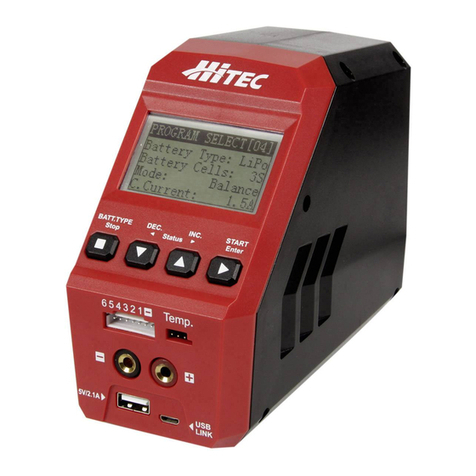
Hi-Tec
Hi-Tec X1RED User manual
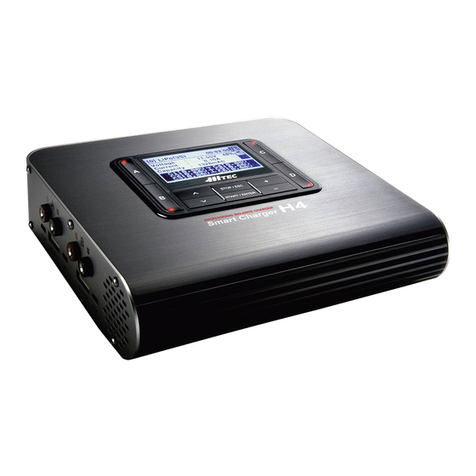
Hi-Tec
Hi-Tec Smart Charger H4 User manual
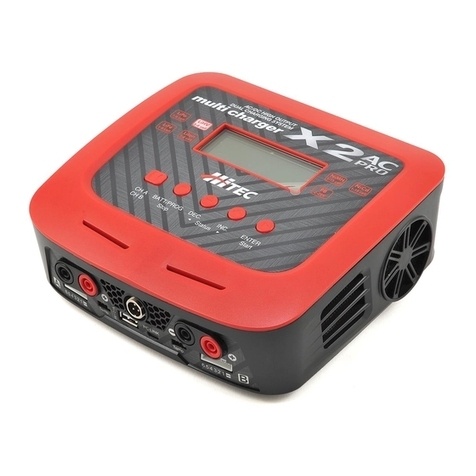
Hi-Tec
Hi-Tec X2 ACPro User manual
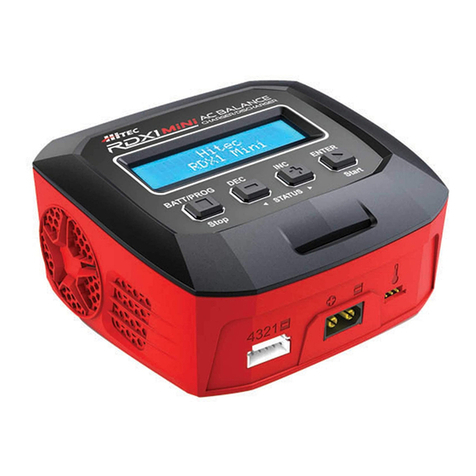
Hi-Tec
Hi-Tec RDX1 Mini User manual

Hi-Tec
Hi-Tec power peak D7 User manual
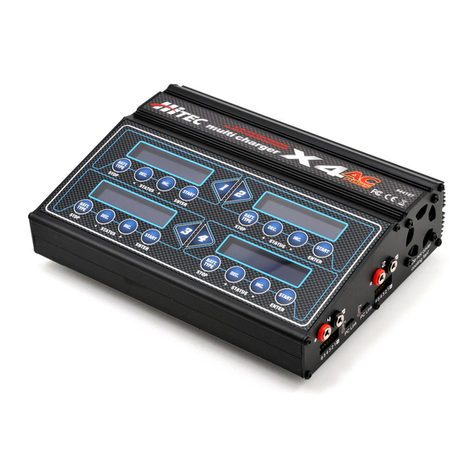
Hi-Tec
Hi-Tec multi cahrger X4 AC Plus User manual
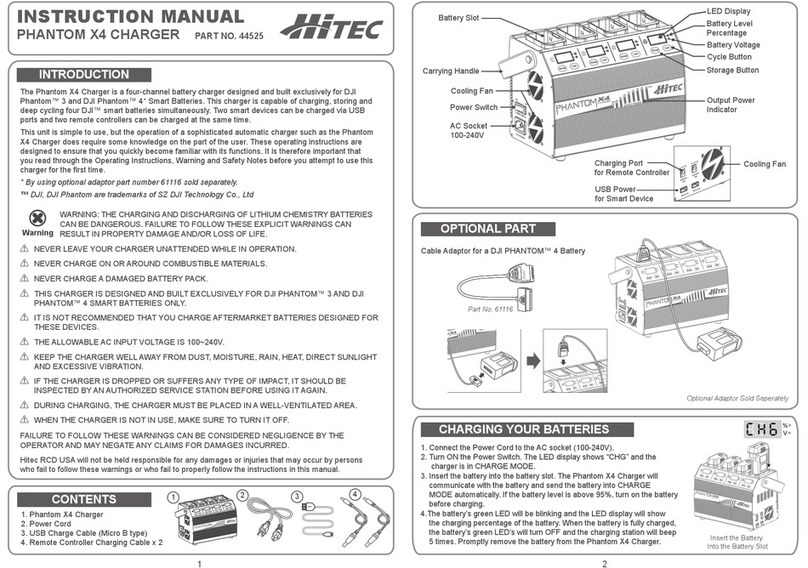
Hi-Tec
Hi-Tec 44525 User manual
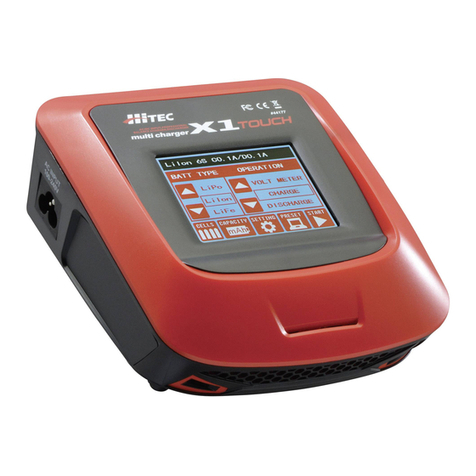
Hi-Tec
Hi-Tec X1 Touch User manual
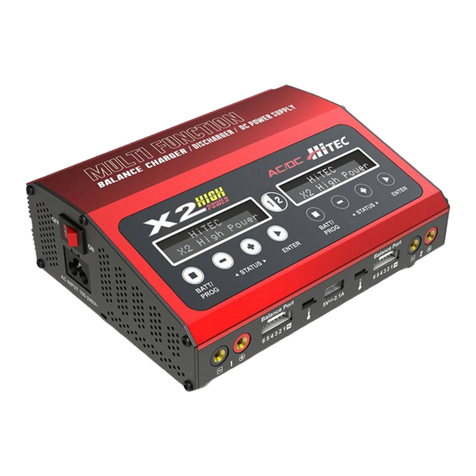
Hi-Tec
Hi-Tec X2 Ultima User manual
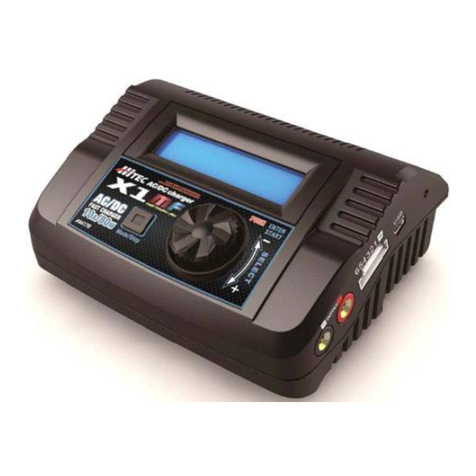
Hi-Tec
Hi-Tec X1MF User manual
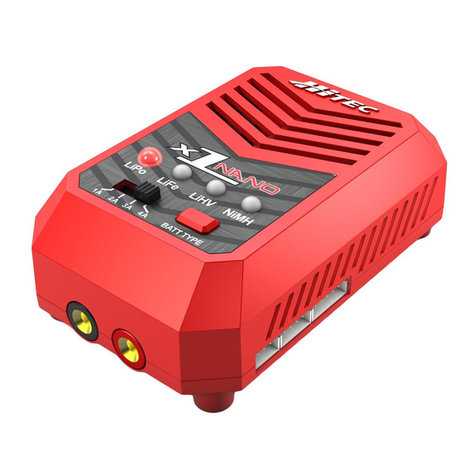
Hi-Tec
Hi-Tec X1 Nano User manual

Hi-Tec
Hi-Tec RDX1 Mini User manual
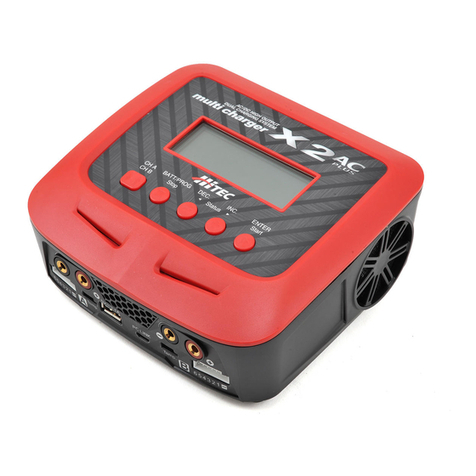
Hi-Tec
Hi-Tec X2 AC Plus Black Edition User manual
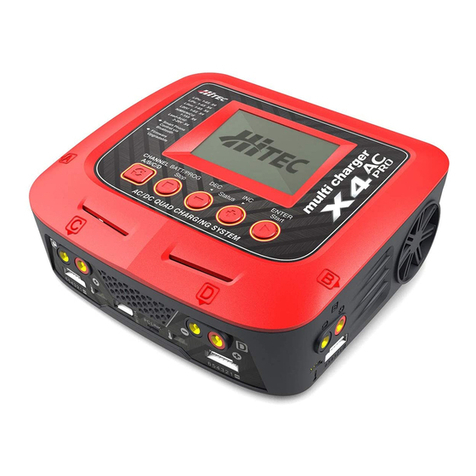
Hi-Tec
Hi-Tec X4 AC Pro User manual
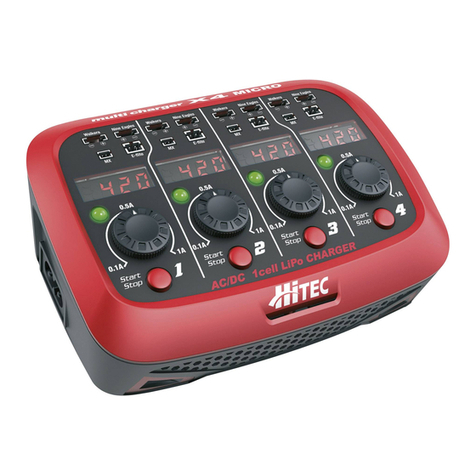
Hi-Tec
Hi-Tec X4 MICRO User manual

Hi-Tec
Hi-Tec RDX 2 PRO User manual

Hi-Tec
Hi-Tec 44246 User manual
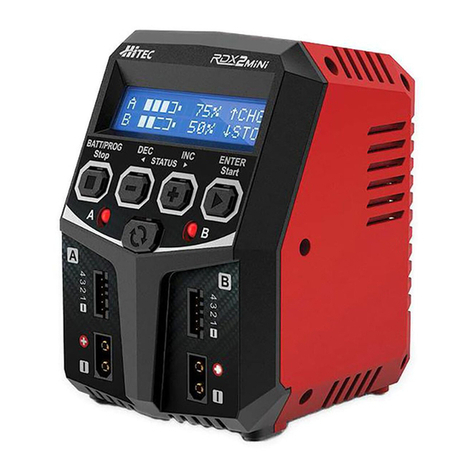
Hi-Tec
Hi-Tec RDX 2 MiNi User manual

Hi-Tec
Hi-Tec X4 User manual
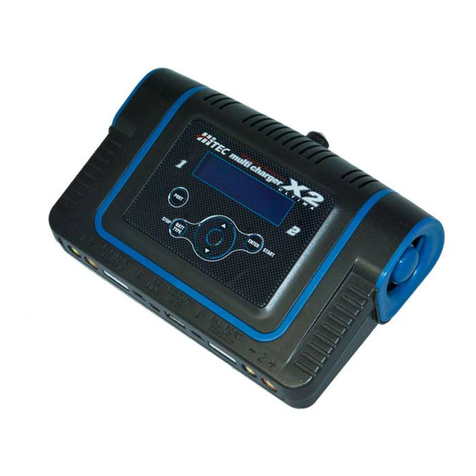
Hi-Tec
Hi-Tec X2 Ultima User manual


